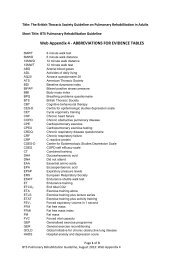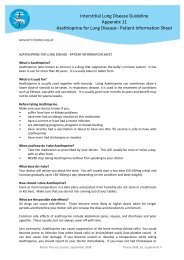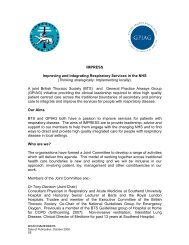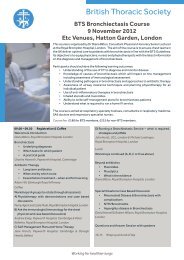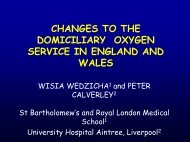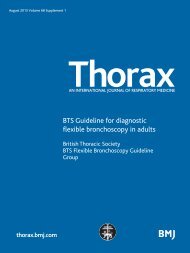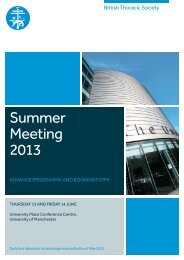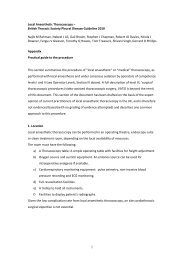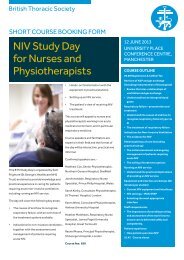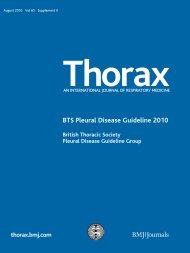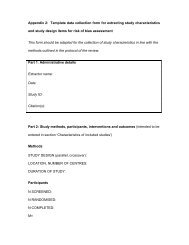Guidelines for the management of community ... - Brit Thoracic
Guidelines for the management of community ... - Brit Thoracic
Guidelines for the management of community ... - Brit Thoracic
Create successful ePaper yourself
Turn your PDF publications into a flip-book with our unique Google optimized e-Paper software.
BTS guidelines<br />
Population-based studies <strong>of</strong> <strong>the</strong> incidence <strong>of</strong> CAP requiring<br />
hospitalisation have reported overall incidences <strong>of</strong> 1.1 per 1000<br />
adult population per annum in Canada, 27 [Ib] 2.6 per 1000 in<br />
Spain, 6 [II] 2.7 per 1000 population in Ohio, USA 6 [Ib] and 4 per<br />
28 [III]<br />
1000 population in Pennsylvanian hospitals, USA.<br />
Increasing age was associated with an increasing incidence <strong>of</strong><br />
admission to hospital with CAP in Canada; from 1.29 per 1000<br />
persons aged 18–39 years, to 1.91 per 1000 persons aged 40–<br />
29 [III]<br />
54 years, to 13.21 per 1000 persons aged 55 years or above.<br />
A study <strong>of</strong> Hospital Episode Statistics <strong>for</strong> England between 1997<br />
and 2005 showed a rise in hospital admissions <strong>for</strong> pneumonia<br />
over time. The age-standardised incidence <strong>of</strong> hospitalisations<br />
with a primary diagnosis <strong>of</strong> pneumonia increased by 34%<br />
between 1997–8 and 2004–5, from 1.48 to 1.98 per 1000<br />
12 [III]<br />
population. This increase was more marked in older adults.<br />
The proportion <strong>of</strong> adults with CAP who require hospital<br />
admission in <strong>the</strong> UK has been reported as between 22% 23 [Ib] and<br />
42%. 30 [III] This figure varies in o<strong>the</strong>r countries, probably<br />
dependent on <strong>the</strong> structure <strong>of</strong> <strong>the</strong> primary and secondary<br />
healthcare system. In a Finnish prospective longitudinal<br />
population study, 42% were admitted to hospital. 24 [Ib] A 50%<br />
admission rate was reported in one study from Spain, but this<br />
only included patients referred by <strong>the</strong>ir general practitioner to<br />
<strong>the</strong> hospital emergency service <strong>for</strong> confirmation <strong>of</strong> <strong>the</strong> diagnosis<br />
10 [II]<br />
<strong>of</strong> CAP.<br />
In Seattle, USA 15% were hospitalised. 31 [Ib] In <strong>the</strong> Pneumonia<br />
Patient Outcomes Research multicentre prospective cohort<br />
study <strong>of</strong> CAP in America, 41% <strong>of</strong> adults studied were managed<br />
initially as outpatients and <strong>the</strong> remainder were admitted to<br />
hospital. Of those initially treated as outpatients, only 7.5%<br />
were subsequently admitted, 56% because <strong>of</strong> <strong>the</strong> CAP and <strong>the</strong><br />
32 [Ib]<br />
rest because <strong>of</strong> worsening <strong>of</strong> a comorbid illness.<br />
The proportion <strong>of</strong> adults hospitalised with CAP who require<br />
<strong>management</strong> on an intensive care unit (ICU) varies from 1.2%<br />
in one Spanish study 12 [II] and 5% in <strong>the</strong> BTS multicentre study 65<br />
[II]<br />
to 10% in ano<strong>the</strong>r Spanish study. 33 [II] Previously, between<br />
8% 13 [II] and 10% 34 [III] <strong>of</strong> medical admissions to an ICU were<br />
found to be <strong>for</strong> severe CAP. An analysis <strong>of</strong> admissions to ICUs<br />
across England, Wales and Nor<strong>the</strong>rn Ireland between 1995 and<br />
2004 found CAP to be <strong>the</strong> cause <strong>of</strong> 5.9% <strong>of</strong> all ICU admissions.<br />
There was an increase in CAP requiring intensive care from 12.8<br />
per unit in 1996 to 29.2 per unit in 2004. This represented an<br />
increase <strong>of</strong> 128% compared with a rise in <strong>the</strong> total number <strong>of</strong><br />
13 [III]<br />
admissions to ICUs <strong>of</strong> only 24%.<br />
Summary<br />
c The annual incidence in <strong>the</strong> <strong>community</strong> is 5–11 per 1000<br />
adult population. [Ib]<br />
c CAP accounts <strong>for</strong> 5–12% <strong>of</strong> all cases <strong>of</strong> adult lower<br />
respiratory tract infection managed by general practitioners<br />
in <strong>the</strong> <strong>community</strong>. [Ib]<br />
c The incidence varies markedly with age, being much higher<br />
in <strong>the</strong> very young and <strong>the</strong> elderly. [Ib]<br />
c Between 22% and 42% <strong>of</strong> adults with CAP are admitted to<br />
hospital. [Ib]<br />
c The incidence <strong>for</strong> patients requiring admission to hospital<br />
varies with age from 1.29 per 1000 persons aged 18–39 years<br />
up to 13.21 per 1000 persons aged >55 years. [III]<br />
c The age-standardised incidence <strong>of</strong> admission to hospital<br />
increased by 34% from 1.48 to 1.98 per 1000 population<br />
between 1997–8 and 2004–5 in England.<br />
c Between 1.2% and 10% <strong>of</strong> adults admitted to hospital with<br />
CAP are managed on an ICU. [II]<br />
Thorax 2009;64(Suppl III):iii1–iii55. doi:10.1136/thx.2009.121434<br />
2.2 What is <strong>the</strong> mortality <strong>of</strong> CAP?<br />
The reported mortality <strong>of</strong> adults with CAP managed in <strong>the</strong><br />
<strong>community</strong> is low and less than 1%. 15 23 32 [II] [Ib] [Ib] Deaths in <strong>the</strong><br />
<strong>community</strong> due to CAP are rare in <strong>the</strong> UK. In one study only<br />
seven cases were identified by coroners’ post mortems over<br />
1 year in Nottingham, a large urban city <strong>of</strong> three quarters <strong>of</strong> a<br />
23 [III]<br />
million, giving an incidence <strong>of</strong> 1 per 100 000.<br />
The reported mortality <strong>of</strong> adults hospitalised with CAP has<br />
varied widely. The BTS multicentre study reported a mortality<br />
<strong>of</strong> 5.7%, 6 [II] but did not study patients over <strong>the</strong> age <strong>of</strong> 74 years.<br />
O<strong>the</strong>r UK studies have reported mortalities <strong>of</strong> 8%, 35 [II] 36 [Ib]<br />
12%<br />
and 14%. 37 [Ib] Countries with similar healthcare systems have<br />
reported hospital mortality rates <strong>of</strong> 4%, 24 [Ib] 7%, 38 [II] 241 [Ib]<br />
8%<br />
39 [Ib]<br />
and 10%.<br />
The longer term mortality <strong>of</strong> CAP is high, reflecting <strong>the</strong><br />
frailty <strong>of</strong> many patients who develop CAP in <strong>the</strong> first instance.<br />
In a US study <strong>the</strong> 90-day all-cause mortality was 8.7% and<br />
mortality at 5.9 years was 39.1%. Age, level <strong>of</strong> education, male<br />
sex and nursing home residence were independently associated<br />
with long-term mortality. 40 [II] O<strong>the</strong>r studies found long-term<br />
mortality to be 20.8% at 1 year, 34.1% at a mean <strong>of</strong> 901 days<br />
41 [II]<br />
and 35.8% at 5 years.<br />
The mortality <strong>of</strong> patients with severe CAP requiring<br />
admission to an ICU is high. This is likely to be particularly<br />
evident in health services such as <strong>the</strong> National Health Service<br />
where ICU beds are at a premium, such that only critically ill<br />
patients in need <strong>of</strong> assisted ventilation can be admitted. ICUbased<br />
studies in <strong>the</strong> UK have reported mortalities <strong>of</strong> over<br />
50%, 25 34 42 43 [III] [III] [III] [III] although a more recent analysis <strong>of</strong><br />
admissions to ICUs across England, Wales and Nor<strong>the</strong>rn Ireland<br />
between 1995 and 2004 reported a mortality <strong>of</strong> 34.9% <strong>for</strong><br />
patients with CAP. 13 [III] Nearly all <strong>of</strong> <strong>the</strong> patients required<br />
assisted ventilation. By contrast, <strong>the</strong> mortality rate in a large<br />
multicentre study <strong>of</strong> severe CAP in four French ICUs reported a<br />
mortality <strong>of</strong> 35% with a ventilation rate <strong>of</strong> only 52%. 25 [Ib]<br />
Similar figures were reported from ano<strong>the</strong>r ICU-based study in<br />
France. 44 [II] In a specialist ICU in Spain, a mortality <strong>of</strong> 22% was<br />
reported, rising to 36% in <strong>the</strong> 61% <strong>of</strong> patients who required<br />
33 [II]<br />
assisted ventilation.<br />
Summary<br />
c The reported mortality <strong>of</strong> adults with CAP managed in <strong>the</strong><br />
<strong>community</strong> in <strong>the</strong> UK is very low and less than 1%. [Ib]<br />
c The reported mortality <strong>of</strong> adults hospitalised with CAP in<br />
<strong>the</strong> UK has varied between 5.7% and 14%. [Ib]<br />
c The mortality <strong>of</strong> patients with severe CAP requiring<br />
admission to an ICU in <strong>the</strong> UK is high at over 30%. [III]<br />
c The long-term mortality <strong>of</strong> CAP is between 35.8% and<br />
39.1% at 5 years. [II]<br />
2.3 What are <strong>the</strong> economic consequences <strong>of</strong> CAP?<br />
A prevalence-based burden <strong>of</strong> illness study estimated that CAP<br />
in <strong>the</strong> UK incurred a direct healthcare cost <strong>of</strong> £441 million<br />
annually at 1992–3 prices. The average cost <strong>for</strong> managing<br />
pneumonia in <strong>the</strong> <strong>community</strong> was estimated at £100 per<br />
episode compared with £1700–5100 when <strong>the</strong> patient required<br />
admission to hospital. Hospitalisation accounted <strong>for</strong> 87% <strong>of</strong> <strong>the</strong><br />
30 [III]<br />
total annual cost.<br />
A similar exercise conducted in 1997 in <strong>the</strong> USA calculated<br />
that annual costs <strong>of</strong> CAP amounted to $8.4 billion, 52% <strong>of</strong> <strong>the</strong><br />
costs being <strong>for</strong> <strong>the</strong> inpatient care <strong>for</strong> 1.1 million patients and <strong>the</strong><br />
remaining costs <strong>for</strong> <strong>the</strong> 4.4 million outpatient consultations.<br />
The average hospital length <strong>of</strong> stay varied between 5.8 days <strong>for</strong><br />
iii11



